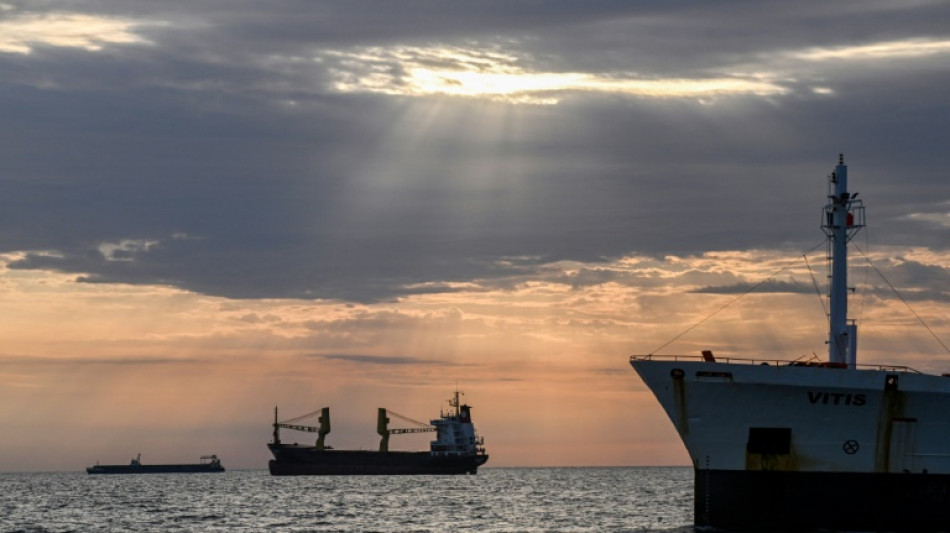
RBGPF
-0.4400

In the Ukrainian port of Izmail, on the Danube river that marks the border with Romania, rows of trucks filled with grain stand in line.
Dozens of kilometres (miles) from there, at Romania's port of Sulina, where the river flows into the Black Sea, ships are waiting to be loaded.
Sailors say there have never been so many ships of all kinds and under so many flags dotting the horizon at Sulina.
They are waiting to reach Ukraine to be loaded with food -- ever since Moscow's blockade of its neighbour's seaports has paralysed grain exports from one of the world's largest producers.
"The alternative is the Danube. The big problem is the capacity of the infrastructure on the river," Yuriy Dimchoglo, former vice-president of the Odessa regional council, told AFP.
Since Russia invaded Ukraine in February, only 1.5 million tonnes of grain have been exported via the Danube, he said, while 20 to 25 million tonnes are blocked in the country, according to the government.
- 'Feed the world' -
Some 35 kilometres (20 miles) from Izmail port, farmer Vyacheslav Zyabkin said he had still not shipped any of his produce -- "not even a kilogramme" -- via the Danube because purchase prices were below operating costs.
He said shipping via the Danube was especially suitable for farmers who have small quantities to sell.
But even for those who do choose this route, the journey is strewn with obstacles.
As trucks converge from the south of Ukraine in the hope of unloading their cargo via the Danube, huge traffic jams have formed.
And Izmail too is very crowded.
"Before the war, it took one day, now it takes three days" to unload there, trucker Sergiy Gavrilenko told AFP.
"We take it upon ourselves because it's for the good of the country and to feed the world," said the 45-year-old as he poured a can of water over himself to cool off under the scorching hot temperature of 32 degrees Celsius (89.6 degrees Fahrenheit).
- 'No respite' -
The boats that take over, and transport the goods down the Danube before reaching the Black Sea, keep coming.
Off Sulina, nearly a hundred of them wait on average between seven and 10 days until they can take the canal to the Ukrainian ports.
"Our volume of work has increased a lot... We are hard at work from sunrise to sunset," said Gabriel Danila-Mihalcea, 28, pilot of a boat plying between Sulina and the Black Sea.
His mission is crucial -- he shuttles pilots to each of the ships in the harbour. Under a rule endorsed in 1948 by the Danube Convention such a pilot must steer ships through the Sulina canal.
"We have no respite," one of the pilots said on condition of anonymity, while ship mechanic Mihai Calin, 48, said "a record" 400 boats passed through Sulina last month.
A senior transport ministry official Ion Popa confirmed traffic last month had tripled compared to May last year.
He told AFP that managing this increase was "an effort for Romania", adding he hoped for help from Brussels.
After blaming each other for the backlog, Romania and Ukraine set up a joint command at the end of May that decides the order in which ships enter the Danube.
Those chartered for the transport of grain now have priority.
Separately, at the Romanian Black Sea port of Constanta, nearly 700,000 tonnes of Ukrainian agricultural produce have been loaded since the start of the conflict, arriving there on board barges, trains and trucks, Popa said.
But the queues at road and rail border crossings are getting longer every day.
Before the war, Ukraine was the fourth-largest wheat and corn exporter in the world.
Russia, too, is a grain superpower and 30 percent of the world's grain exports originate from the warring countries.
Since the Kremlin launched its invasion of Ukraine on February 24, grain and oil prices have soared.
The UN fears a "hurricane of hunger" -- mainly in African countries that import more than half of their wheat from either Russia or Ukraine.
R.Bernasconi--NZN